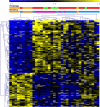Gene expression profiling of familial and sporadic interstitial pneumonia
- PMID: 16998095
- PMCID: PMC1899261
- DOI: 10.1164/rccm.200601-062OC
Gene expression profiling of familial and sporadic interstitial pneumonia
Abstract
Rationale: Idiopathic interstitial pneumonia (IIP) and its familial variants are progressive and largely untreatable disorders with poorly understood molecular mechanisms. Both the genetics and the histologic type of IIP play a role in the etiology and pathogenesis of interstitial lung disease, but transcriptional signatures of these subtypes are unknown.
Objectives: To evaluate gene expression in the lung tissue of patients with usual interstitial pneumonia or nonspecific interstitial pneumonia that was either familial or nonfamilial in origin, and to compare it with gene expression in normal lung parenchyma.
Methods: We profiled RNA from the lungs of 16 patients with sporadic IIP, 10 with familial IIP, and 9 normal control subjects on a whole human genome oligonucleotide microarray.
Results: Significant transcriptional differences exist in familial and sporadic IIPs. The genes distinguishing the genetic subtypes belong to the same functional categories as transcripts that distinguish IIP from normal samples. Relevant categories include chemokines and growth factors and their receptors, complement components, genes associated with cell proliferation and death, and genes in the Wnt pathway. The role of the chemokine CXCL12 in disease pathogenesis was confirmed in the murine bleomycin model of lung injury, with C57BL/6(CXCR4+/-) mice demonstrating significantly less collagen deposition than C57BL/6(CXCR4+/+) mice. Whereas substantial differences exist between familial and sporadic IIPs, we identified only minor gene expression changes between usual interstitial pneumonia and nonspecific interstitial pneumonia.
Conclusions: Taken together, our findings indicate that differences in gene expression profiles between familial and sporadic IIPs may provide clues to the etiology and pathogenesis of IIP.
Figures







Comment in
-
When it comes to genes--IPF or NSIP, familial or sporadic--they're all the same.Am J Respir Crit Care Med. 2007 Jan 1;175(1):5-6. doi: 10.1164/rccm.200610-1415ED. Am J Respir Crit Care Med. 2007. PMID: 17179494 No abstract available.
-
A new missense mutation in the CASR gene in familial interstitial lung disease with hypocalciuric hypercalcemia and defective granulocyte function.Am J Respir Crit Care Med. 2008 Mar 1;177(5):558-9. doi: 10.1164/ajrccm.177.5.558. Am J Respir Crit Care Med. 2008. PMID: 18296474 No abstract available.
Similar articles
-
Focal interstitial CC chemokine receptor 7 (CCR7) expression in idiopathic interstitial pneumonia.J Clin Pathol. 2006 Jan;59(1):28-39. doi: 10.1136/jcp.2005.026872. J Clin Pathol. 2006. PMID: 16394278 Free PMC article.
-
Gene expression profiling of idiopathic interstitial pneumonias (IIPs): identification of potential diagnostic markers and therapeutic targets.BMC Med Genet. 2017 Aug 18;18(1):88. doi: 10.1186/s12881-017-0449-9. BMC Med Genet. 2017. PMID: 28821283 Free PMC article.
-
Enhanced monocyte chemoattractant protein-3/CC chemokine ligand-7 in usual interstitial pneumonia.Am J Respir Crit Care Med. 2004 Sep 1;170(5):508-15. doi: 10.1164/rccm.200401-002OC. Epub 2004 Jun 10. Am J Respir Crit Care Med. 2004. PMID: 15191918
-
Demystifying idiopathic interstitial pneumonia: time for more etiology-focused nomenclature in interstitial lung disease.Expert Rev Respir Med. 2022 Feb;16(2):235-245. doi: 10.1080/17476348.2022.2030710. Epub 2022 Jan 31. Expert Rev Respir Med. 2022. PMID: 35034567 Free PMC article. Review.
-
Genetic predisposition to respiratory diseases: infiltrative lung diseases.Respiration. 2007;74(6):601-8. doi: 10.1159/000110204. Respiration. 2007. PMID: 18037811 Free PMC article. Review.
Cited by
-
New Insights via RNA Profiling of Formalin-Fixed Paraffin-Embedded Lung Tissue of Pulmonary Fibrosis Patients.Int J Mol Sci. 2023 Nov 25;24(23):16748. doi: 10.3390/ijms242316748. Int J Mol Sci. 2023. PMID: 38069069 Free PMC article.
-
The peripheral blood transcriptome identifies the presence and extent of disease in idiopathic pulmonary fibrosis.PLoS One. 2012;7(6):e37708. doi: 10.1371/journal.pone.0037708. Epub 2012 Jun 22. PLoS One. 2012. PMID: 22761659 Free PMC article.
-
A peptide derived from endostatin ameliorates organ fibrosis.Sci Transl Med. 2012 May 30;4(136):136ra71. doi: 10.1126/scitranslmed.3003421. Sci Transl Med. 2012. PMID: 22649092 Free PMC article.
-
Expression of cilium-associated genes defines novel molecular subtypes of idiopathic pulmonary fibrosis.Thorax. 2013 Dec;68(12):1114-21. doi: 10.1136/thoraxjnl-2012-202943. Epub 2013 Jun 19. Thorax. 2013. PMID: 23783374 Free PMC article.
-
Idiopathic pulmonary fibrosis: diagnostic pitfalls and therapeutic challenges.Multidiscip Respir Med. 2012 Nov 12;7(1):42. doi: 10.1186/2049-6958-7-42. Multidiscip Respir Med. 2012. PMID: 23146172 Free PMC article.
References
-
- Swigris JJ, Kuschner WG, Kelsey JL, Gould MK. Idiopathic pulmonary fibrosis: challenges and opportunities for the clinician and investigator. Chest 2005;127:275–283. - PubMed
-
- Green FH. Overview of pulmonary fibrosis. Chest 2002;122:334S–339S. - PubMed
-
- Nicholson AG, Colby TV, du Bois RM, Hansell DM, Wells AU. The prognostic significance of the histologic pattern of interstitial pneumonia in patients presenting with the clinical entity of cryptogenic fibrosing alveolitis. Am J Respir Crit Care Med 2000;162:2213–2217. - PubMed
-
- Daniil ZD, Gilchrist FC, Nicholson AG, Hansell DM, Harris J, Colby TV, du Bois RM. A histologic pattern of nonspecific interstitial pneumonia is associated with a better prognosis than usual interstitial pneumonia in patients with cryptogenic fibrosing alveolitis. Am J Respir Crit Care Med 1999;160:899–905. - PubMed
-
- Travis WD, King TE, Bateman ED, Lynch DA, Capron F, Center D, Colby TW, Cordier J-F, Du Bois RM, Grenier GJ, et al. American Thoracic Society/European Respiratory Society International multidisciplinary consensus classification of the idiopathic interstitial pneumonias. Am J Respir Crit Care Med 2002;165:277–304. - PubMed
Publication types
MeSH terms
Substances
Grants and funding
LinkOut - more resources
Full Text Sources
Other Literature Sources
Medical
Molecular Biology Databases

